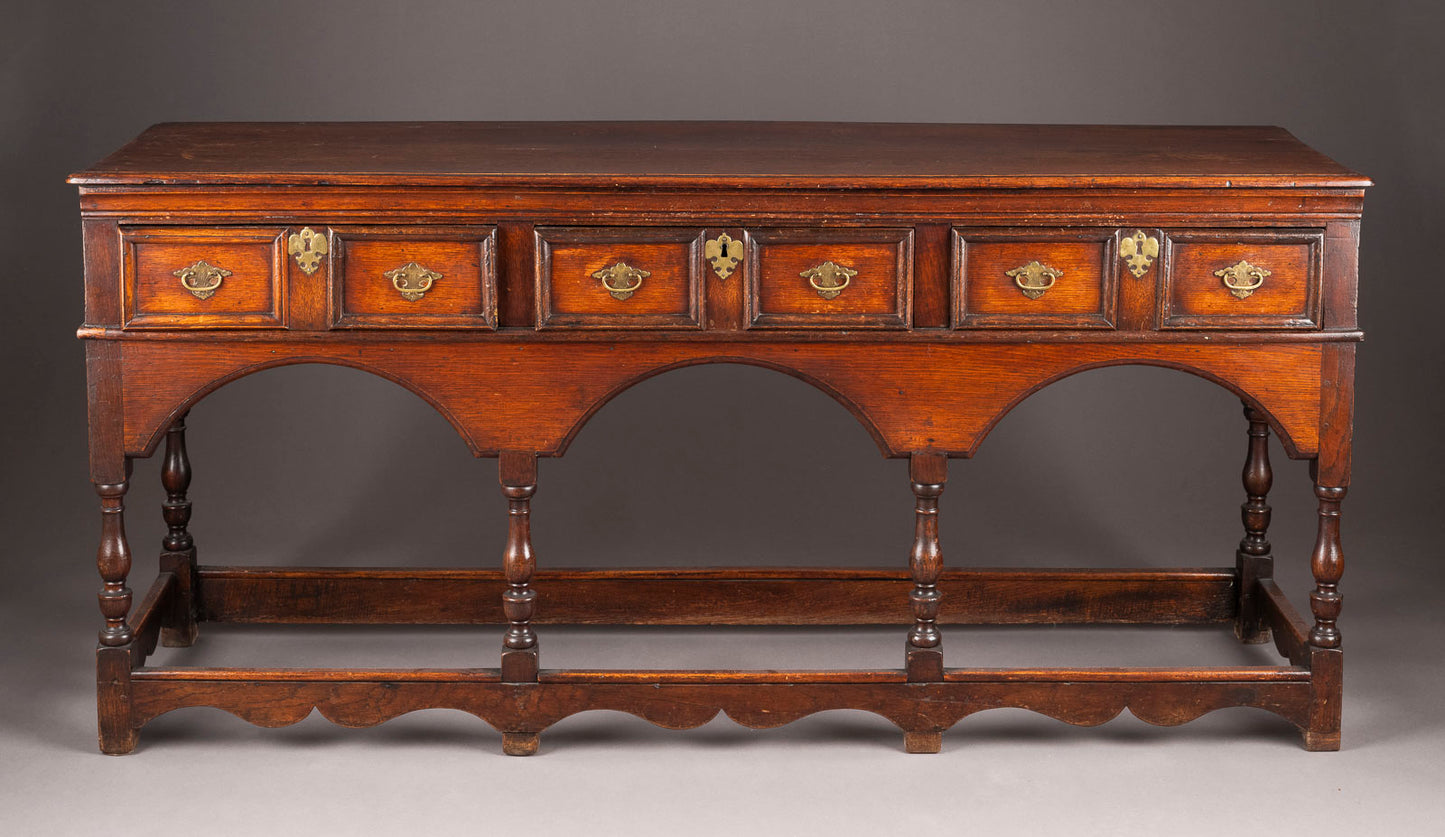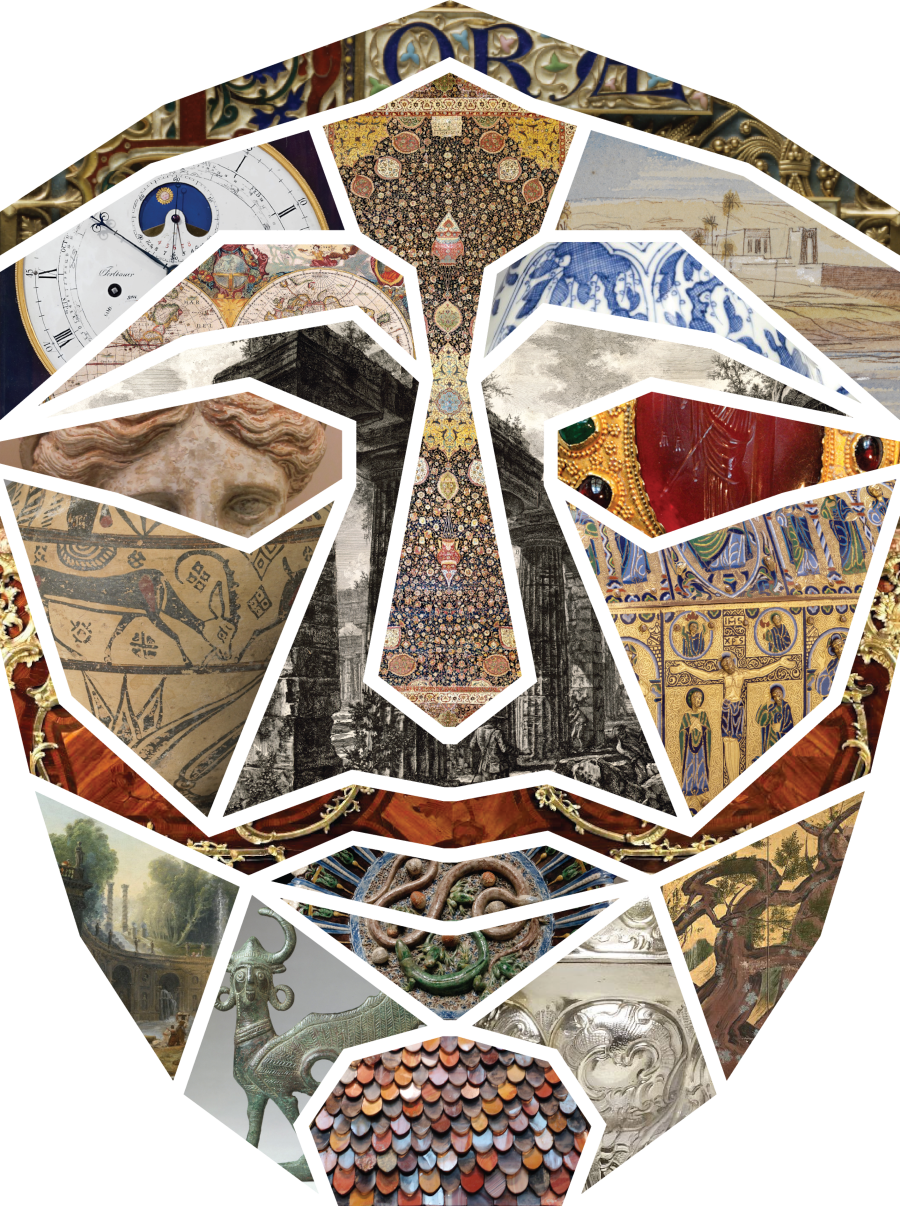My Store
Rare Oak English Sideboard c.1700 - Turned Legs Original Hand-Forged Escutcheons
Rare Oak English Sideboard c.1700 - Turned Legs Original Hand-Forged Escutcheons
Couldn't load pickup availability
Rare Spectacular Oak English Sideboard c.1700 - Original Hand-Forged Escutcheons
An exceptionally rare and museum-quality English oak sideboard dating to circa 1700, featuring magnificent turned legs, three drawers with original hand-forged brass escutcheons, and three open arcades supported by eight full columns. This spectacular piece represents late 17th/early 18th-century English furniture craftsmanship at its finest and offers collectors an extraordinary opportunity to acquire an authentic William & Mary or early Queen Anne period sideboard of exceptional quality and provenance.
Historical Period - William & Mary to Queen Anne
This sideboard dates to the transitional period between the William & Mary (1689-1702) and Queen Anne (1702-1714) eras, one of the most significant periods in English furniture history. This was when English furniture making achieved new levels of sophistication, incorporating Continental influences while developing distinctively English characteristics. Furniture from this period is exceptionally rare, as relatively few domestic pieces survived the subsequent 320+ years of use, fashion changes, and modernization.
Solid Oak Construction
Constructed entirely of solid English oak, this sideboard showcases the magnificent grain patterns and warm honey tones that develop in oak over centuries. The use of wide oak planks indicates timber from mature trees, now virtually impossible to obtain. Oak was the preferred wood for quality English furniture during this period, valued for its strength, durability, and beautiful aging characteristics. The wood has developed the rich, deep patina that only centuries of careful use and natural aging can create - a patina that cannot be artificially replicated and represents one of antique furniture's most valued characteristics.
Turned Legs - Masterful Craftsmanship
The sideboard stands on spectacular turned legs, each individually shaped on a lathe by a master turner. The elegant baluster forms, crisp details, and perfect symmetry demonstrate extraordinary skill and the use of properly seasoned timber. Turned legs of this quality and period are increasingly rare, as many pieces were later cut down, modified, or damaged. The retention of original turned legs in excellent condition dramatically enhances this sideboard's authenticity, aesthetic appeal, and investment value.
Three Drawers with Original Hand-Forged Brass Escutcheons
The upper section features three drawers, each retaining its original hand-forged brass escutcheons (keyhole surrounds). These escutcheons were individually crafted by blacksmiths, each bearing the subtle irregularities and character marks that distinguish hand-forged metalwork from later machine-made hardware. The retention of original period hardware is exceptionally rare on furniture of this age, as pieces were often 'updated' with Victorian or later fittings. These original escutcheons confirm the sideboard's untouched, authentic condition and dramatically enhance its value to serious collectors.
Three Open Arcades with Eight Full Columns
The lower section features three open arcades divided by eight full turned columns, creating a rhythmic architectural composition that demonstrates sophisticated design sensibility. This open storage area would have been used for displaying pewter, ceramics, or other household items. The columns' turning matches the quality of the legs, showing this piece was executed by highly skilled craftsmen working to exacting standards. The architectural quality of this design elevates the sideboard beyond mere utility into the realm of furniture as art.
Proportions and Design Excellence
The sideboard's impressive dimensions (H. 76 cm, L. 164 cm, D. 47 cm) create commanding presence while maintaining elegant proportions. The relationship between height, length, and depth demonstrates sophisticated understanding of visual balance and spatial harmony. The piece is substantial enough to anchor a room while remaining human in scale. This combination of presence and proportion explains why period English furniture continues to be prized by collectors and decorators worldwide.
Condition - Very Good
Remarkably well-preserved for its age, this sideboard remains in very good condition with wear commensurate with over 320 years of careful use. All structural elements remain sound, drawers function properly, joints are tight, and the oak shows the honest patina of age without significant damage or inappropriate restoration. The retention of original turned legs, original hardware, and authentic surface patina represents exceptional preservation. This level of originality and condition is increasingly rare in early 18th-century furniture and dramatically enhances both aesthetic appeal and investment value.
Rarity and Collectibility
Sideboards of this age, quality, and completeness are exceptionally rare. Most period pieces have been altered, damaged, or lost over three centuries. Finding an example with original turned legs, original hardware, and authentic patina intact is extraordinary. This rarity, combined with the piece's aesthetic power and historical significance, positions it as a museum-quality acquisition opportunity. Comparable examples reside in major museum collections and distinguished private holdings.
Investment Value
Early 18th-century English oak furniture with original elements and documented period represents the pinnacle of furniture collecting and investment. As authentic period pieces become scarcer and appreciation for original, unrestored furniture grows, examples like this sideboard show consistent appreciation. The combination of age, rarity, quality, condition, and aesthetic appeal positions this piece as both a magnificent functional object and an exceptional investment.
Provenance and Authentication
Comprehensive authentication available including wood analysis, hardware examination, construction technique analysis, and comparative research with documented period examples. The sideboard's construction methods, turning styles, hardware, and overall design all confirm its circa 1700 dating. Detailed documentation provided to serious collectors including condition reports, historical research, and insurance valuation.
Display and Use
This sideboard's commanding presence and warm oak tones make it suitable for various settings - dining rooms, entrance halls, living areas, or libraries. It provides substantial storage while serving as a focal point and conversation piece. The piece's historical significance and aesthetic power create atmosphere and character in any interior, from period country houses to sophisticated urban residences. Many collectors use such pieces for their original purpose - displaying ceramics, silver, or decorative objects - while others appreciate them purely as sculptural furniture art.
Cultural and Historical Legacy
This sideboard represents a tangible link to early 18th-century English domestic life, craftsmanship traditions, and aesthetic values. It embodies an era when furniture was built to last generations, when craftsmen took pride in their work, and when beautiful objects were integrated into daily life. Owning such a piece means becoming a custodian of this extraordinary heritage and ensuring its preservation for future generations.
This is a must-see piece that photographs cannot fully capture. Available for viewing by appointment at Artemisia Fine Arts & Antiques Ltd, Malta's premier gallery for museum-quality English antique furniture. We provide expert consultation, authentication services, conservation coordination, insurance valuation, and international shipping with specialized antique furniture handlers. This represents a once-in-a-lifetime acquisition opportunity. Serious inquiries from qualified collectors and institutions welcome.
Share




